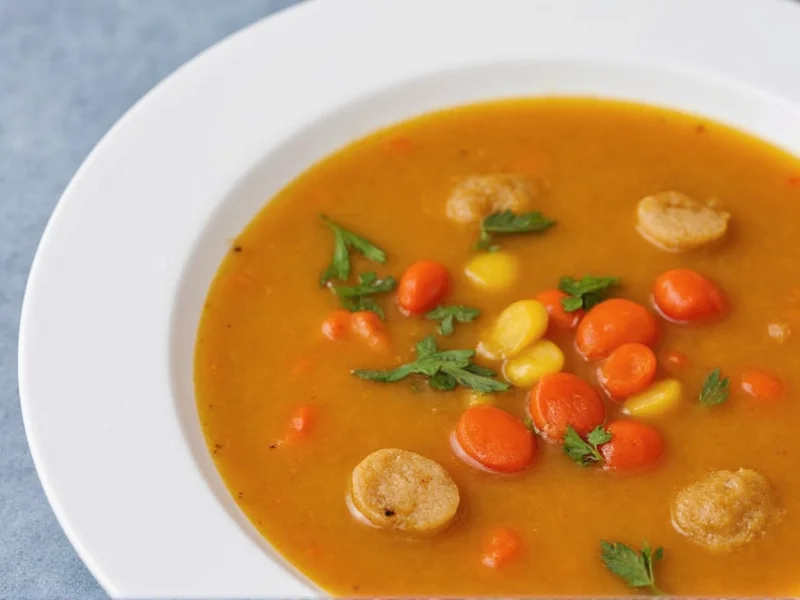Understanding proper soup storage is crucial for food safety and preventing foodborne illness. When handled correctly, soup can be a convenient and safe meal option for several days after preparation. This guide provides evidence-based recommendations from food safety experts to help you determine exactly how long can soup stay in the fridge without compromising your health.
Standard Refrigeration Guidelines for Different Soup Types
The shelf life of soup in your refrigerator depends primarily on its ingredients. Here's a detailed breakdown of how long soup lasts in the fridge based on composition:
| Soup Type | Refrigerator Shelf Life | Critical Safety Notes |
|---|---|---|
| Clear broth-based soups (vegetable, chicken, beef) | 3-4 days | Ensure meat is fully cooked before adding to broth |
| Cream-based soups (bisques, chowders) | 2-3 days | Dairy accelerates spoilage; check for sour smell |
| Seafood soups and chowders | 1-2 days | Seafood spoils fastest; consume promptly |
| Soups with rice, pasta, or potatoes | 3 days | Starchy ingredients break down faster |
| Bean and legume soups | 4-5 days | Acidic ingredients like tomatoes extend freshness |
Factors That Affect How Long Soup Stays Fresh
Several variables influence how long homemade soup lasts in the refrigerator, beyond just the ingredient list:
Proper Cooling Technique
The speed at which you cool soup after cooking significantly impacts its shelf life. Never place a hot pot directly in your refrigerator, as this raises the internal temperature and creates a breeding ground for bacteria. Instead:
- Divide large batches into shallow containers (no deeper than 2 inches)
- Cool soup to 70°F within 2 hours, then to 40°F within 4 hours
- Use an ice bath for rapid cooling of large quantities
Storage Container Selection
The container you choose affects how long soup stays good in the fridge. Optimal storage practices include:
- Airtight glass or BPA-free plastic containers
- Filling containers to within 1 inch of the top to minimize air exposure
- Labeling containers with preparation date
- Avoiding storing soup in the refrigerator door (temperature fluctuations)
Recognizing When Soup Has Spoiled
Knowing how to tell if soup is bad in the fridge could prevent food poisoning. Watch for these critical warning signs:
Visual Indicators
- Mold growth (any visible fuzzy spots, even small ones)
- Unusual separation that doesn't reincorporate when stirred
- Cloudy broth in previously clear soups
Olfactory Indicators
- Sour or unpleasant odor (different from original aroma)
- "Off" smell that wasn't present when first made
Texture Changes
- Slippery or slimy texture on ingredients
- Excessive thickness or curdling (beyond normal settling)
When in doubt, throw it out. Consuming spoiled soup can cause foodborne illnesses with symptoms appearing within hours. The USDA recommends discarding any refrigerated soup that shows even minor signs of spoilage.
Maximizing Soup Freshness: Best Practices
Follow these professional food safety tips to extend how long soup remains safe in the refrigerator:
Temperature Control
Maintain your refrigerator at 40°F (4°C) or below. Use a refrigerator thermometer to verify actual temperature, as built-in dials are often inaccurate. The danger zone for food safety is between 40°F and 140°F, where bacteria multiply rapidly.
Reheating Guidelines
When reheating refrigerated soup, bring it to a rolling boil for at least 3 minutes to eliminate potential bacteria. The FDA recommends reheating leftovers to an internal temperature of 165°F. Never partially reheat soup and return it to the refrigerator.
Freezing as an Alternative
If you won't consume soup within the recommended timeframe, freezing extends shelf life significantly:
- Most soups freeze well for 4-6 months
- Leave 1-inch headspace in containers for expansion
- Consider freezing in portion-sized containers
- Thaw frozen soup in the refrigerator, not at room temperature
Special Considerations for Different Soup Varieties
Certain soup types require special attention when determining how long they last in the refrigerator:
Cream-Based Soups
Cream of mushroom, broccoli cheddar, and other dairy-containing soups have a shorter shelf life of 2-3 days. The dairy components separate and sour more quickly than broth-based soups. If you notice curdling or a sour smell, discard immediately.
Seafood Soups
Clam chowder, fish stews, and other seafood soups should be consumed within 1-2 days. Seafood proteins break down rapidly, and any off odor indicates spoilage. The USDA considers seafood the most perishable protein source.
Soups with Starchy Ingredients
Soups containing rice, pasta, or potatoes maintain quality for about 3 days. These ingredients continue absorbing liquid, becoming mushy over time. For best results, cook starchy components separately and add when reheating.
Food Safety Authority Recommendations
Both the USDA Food Safety and Inspection Service and the FDA provide clear guidelines on how long soup remains safe in the refrigerator. Their joint recommendation states that cooked food, including soup, should not remain in the "danger zone" (40°F-140°F) for more than 2 hours. This two-hour rule is critical for preventing bacterial growth that causes foodborne illness.
The FoodKeeper app, developed by USDA, Cornell University, and FDA, specifically recommends 3-4 days for most cooked soups in the refrigerator. Commercially canned soups that have been opened should follow the same guidelines as homemade soups once transferred to proper storage containers.











 浙公网安备
33010002000092号
浙公网安备
33010002000092号 浙B2-20120091-4
浙B2-20120091-4